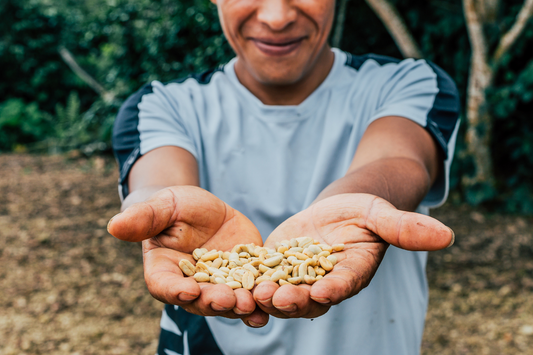
Do Cafés Charge Too Much?
Share
Have you ever ordered a latte from a trendy café and been taken aback by the total cost? How could a cup of coffee cost that much? Beans, water, and a touch of foamed milk—what's that cost, $0.50? These people must be making a killing.
It's a valid question, and this article attempts to offer an alternative perspective and provide you with some solutions to save money while still supporting your local coffee shop.
Cafes are ubiquitous, but they are relatively low-profit businesses. Despite their extravagant prices for hot bean juice, many cafés are just scraping by, and owners rarely communicate this problem with one another.
Believe it or not, cafés operate on very tight margins, with profitability ranging from as low as 2.5% to as high as 8%—probably a fair bit lower than you'd expect. Despite the seemingly high price point, coffee and espresso-based drinks are considered comparatively low-ticket items within the food service industry.
Think about it: you have to sell a lot of $5.00 cups of coffee to cover your operating costs—wages, rent, ingredients, merchandise, utilities, insurance, maintenance, marketing, and advertising; it all adds up.

Cost breakdown of your average coffee shop:
In most cases, labor is often the greatest operational cost for a café, usually consuming somewhere between 30-35% of their total revenue. At the higher end of that range are specialty coffee shops, where more money needs to be invested in talent, training, employee incentives, and thorough hiring processes. Brilliant latte art, top-notch hospitality, and bar efficiency come at a premium, especially in today's tight labor market, where finding and retaining talented, culture-fit employees is of utmost importance.
Here's a simple example: Let's say a small café has two full-time baristas working 35 hours a week, one part-time barista, and one manager working 40 hours a week:"
Baristas wage minus holidays (1820 hrs x 2) x $17.50/hr
=$63,700
Weekend part-time barista (729 hrs) x $15.50/hr
=$11,300
Manager minus holidays (salaried)
=$49,000/ year
Cost of Hiring/Training = $11,000
$63,700 + $11,300 + $49,000 + $11,000 = $135,000 in annual labour cost
At 30% of gross café needs to be generating $450,000 in annually to support this small team.
Inventory takes another substantial portion of a cafe's revenue, particularly the high volumes of roasted coffee beans and perishable food items. A very busy specialty shop sells anywhere from 300-500 cups of coffee per day, which amounts to 83-139 pounds of fresh, whole bean coffee from their wholesale roasting partner per week.
= (115 lbs x $10.50) * 51 work weeks/year = $61,582 on coffee beans alone
Include fresh items from a local bakery, a vast array of syrups, milk options, teas, RTD beverages and cup formats and they could very well be spending more than a couple grand per week.
= $2470 total inventory consumed per week x 51 work weeks = $125,970 per year
Or 28% of $450,000 in gross sales
The cost per cup or unit of the drink components is relatively low, approximately 20% of the list price. However, the challenge lies in maintaining a diverse inventory of unique ingredients to cater to the preferences of all our customers. As a result, cafes can spend around 25-35% of their sales on consumables and inventory to maintain their selection of food and drink offerings.
Rent and utility costs in a café are heavily location-dependent, typically accounting for only around 10-15% of total expenses. In the example mentioned earlier, with an annual budget of $450,000, this would translate to a monthly expenditure of $3,750 to $5,625. Meanwhile, general and administrative expenses, which encompass accounting, HR, equipment leasing, maintenance, and depreciation, constitute an additional 8-14% of the total.
That’s just the cost of keeping the lights on; now you have to actually bring people into your café. Paid marketing and advertising, hosting community events, offering giveaways, creating seasonal recipes, hiring a social media expert, and cross-promoting with other businesses are some of the ways to attract new customers.

After taxes, there's not much left. You've probably seen the owner behind the espresso bar, working away for 60+ hours a week alongside their baristas. Owning an independent café is a labor of love; those who get into it for the money quickly close up shop and move on to other ventures. The few who stay have a true passion for hospitality, building teams, and an unwavering belief in themselves or the concept they want to bring to life.
How Can I Support my Local Café without breaking the bank?
- Most café’s have corporate offerings, arranging with them to supply your office with batch brewed coffee and an assortment of pastries will come at a larger discount.
- Purchase breakfast or lunch with your coffee; food items tend to be up marked less than drinks alone.
- Buy your shops roasted coffee for brewing at home, a standard 12 oz unit is $15.00-20.00, which means you’ll be paying anywhere from $0.79 to $1.06 per double shot (18g)
- See if your café offers a reusable cup discount, many will give you 50 cents off for bringing your cup into work.
- Refer your friends, repost your beautiful latte on social media or hold a meeting there.


